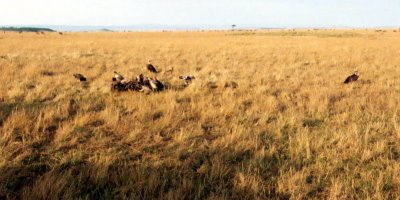 On my recent trip to Africa, I disciplined myself to keep a daily journal of what transpired and how I felt about it. These entries are from that journal.
On my recent trip to Africa, I disciplined myself to keep a daily journal of what transpired and how I felt about it. These entries are from that journal.
Wednesday, October 26, 2005
Experience #4 – Still More Animal Reflections
Zebra – These animals “look like someone painted them,” as one of my colleagues said, are certainly not endangered. They are everywhere. On the drive over, we saw what Americans call “road kill.” It was a zebra! They are very prolific. Unlike their horse cousins, they will sit or lie down just to rest or scratch themselves. We saw hyenas finishing off a zebra kill after the lions had finished.
Gazelle – They appear as graceful as on TV. It was interesting to observe them as they move along the savannah. They keep close together for safety. You will often see one lone male outside of the herd, because the dominant male has expelled him. A baby separated here became breakfast as described in the lion discussion.
Impala – Similar to the gazelle, only smaller. I have a photo of two males fighting, probably over a female . . . just like humans.
Water Buffalo – We have seen these creatures sparingly. There were 3 or 4 in the group we first saw. The second group had about 10-12. The primary comment made to us is that they will put up with your presence for a while, and when they have had enough, they will charge, and sometimes that time period is extremely short. They are large, so that in and of itself is bad. But they do not charge alone. If one charges you, they will all charge you. Most animals will usually go away from a human and only charge if given reason, a water buffalo needs no reason. Also, they know that humans will go for a tree, so one will go ahead of you and cut you off at the tree. You have no where to hide.
Crocodile –Large and vicious. Some members of our group saw them drag a wildebeest under and kill it to eat during a wildebeest river crossing. A wildebeest is no small animal. There are differences anatomically and physically in the crocodile and the alligator, but you can read those anywhere. One difference pointed out to us by the Africans compared to a member of our group who lives near the everglades, is that an alligator will generally run from a human, unless there is no escape or there is some other reason to attack. A crocodile will almost always attack and hunt a human when presented with the opportunity. We stayed clear of the water, not only when they were around, because you cannot always see them.
Rhinoceros – Fierce and large! One female we saw was as large as the jeep we were riding in, and this was no small jeep, it carried nine passengers. They will tolerate your presence for some time. Their eyesight is poor, that is no myth. We drove up to within 25 – 30 feet of the two we saw. After a bit she turned her backside to us and snorted a bit. Ole Masi said, “She is irritated with us now. That was a warning. The next turn will be towards us and a rhino will indeed charge anything once it decides to do so. We had better leave now.” And since a group of rhinos is called a “crash,” we turned and drove away.
Vulture – Numerous, but not as much as I originally thought. They keep the jungle clean after a kill. We drove by 4 or 5 of them on the way in and they were huge!! They were 4 or 5 feel tall and their wingspan had to be at least seven feet. The next day we got photos of 20-25 of them finishing off a wildebeest kill.
Thursday, December 29, 2005
Out of Africa: Part 10 (Continued – C) – Full Day of Debriefing, Reflection and Relaxation
at 11:02 PM
Subscribe to:
Post Comments (Atom)


0 comments:
Post a Comment